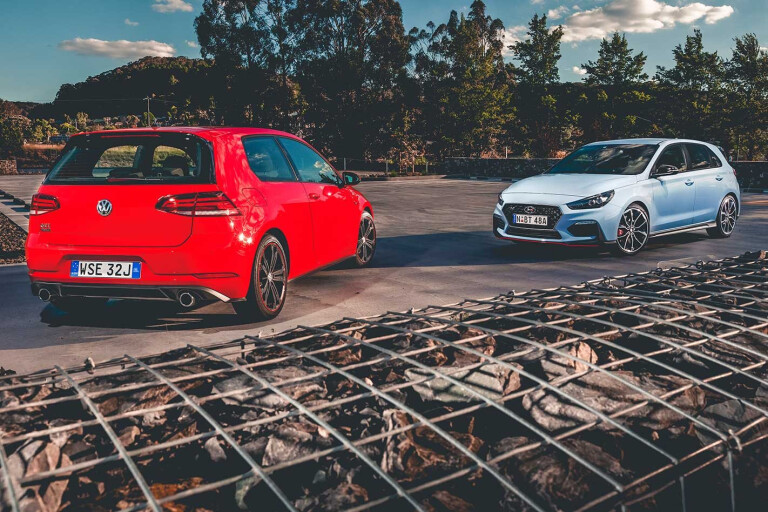
When Hyundai announced the hero colour of N, its new performance brand that would take on the world, it said it was inspired by the “limitlessness” of our atmosphere.
Yet, while its choice of Sky Blue doesn’t strike us as the most intimidating war paint for battle, that hasn’t stopped Hyundai going in hard to establish itself in the fast-car game with some trash talk.
N Performance Development division boss Albert Biermann has called out the current Golf GTI, saying the German all-rounder will fall to pieces on track in the shadow of Hyundai’s first serious performance car, the i30 N.
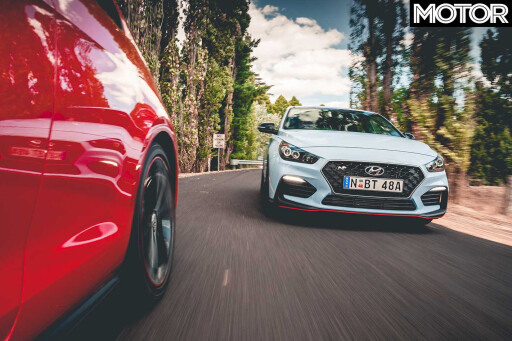 They’re dangerous fighting words, because while the Golf GTI’s legend was fading through the ’90s, Volkswagen has since built it back into a world-class benchmark – one that Namyang’s newly arrived hot hatch needs to beat.
They’re dangerous fighting words, because while the Golf GTI’s legend was fading through the ’90s, Volkswagen has since built it back into a world-class benchmark – one that Namyang’s newly arrived hot hatch needs to beat.
So what has Biermann so cocky? The N has wider tyres than a regular i30 and redesigned suspension, its steering rack is heavily upgraded, while adaptive dampers and brakes stripped from the larger Genesis sedan feature at each corner.
There’s a 2.0-litre inline four pinched from a Sonata, but with a bigger turbo and on overboost it’s good for 202kW and 378Nm. It spins a front LSD that varies lock with an electronically-controlled clutch. There are programmable drive modes, too, and specially developed Pirelli P Zeros.
Underlining Hyundai’s seriousness, the i30 N has landed in Oz for $39,990 (before on-roads), which is $8K less than a Golf GTI Performance and a frighteningly low price for something packing weaponry you’d expect from an AMG A45.
 To prove it won’t be intimidated, however, VW Australia has revived the three-door Golf GTI, which we haven’t seen since the sixth generation. Called the Original, it’s priced at $37,490 for a six-speed manual or $39,990 for the six-speed DSG variant we have here (sadly, a manual wasn’t available for our dates).
To prove it won’t be intimidated, however, VW Australia has revived the three-door Golf GTI, which we haven’t seen since the sixth generation. Called the Original, it’s priced at $37,490 for a six-speed manual or $39,990 for the six-speed DSG variant we have here (sadly, a manual wasn’t available for our dates).
Fewer doors help the GTI shed 26kg, but because things like adaptive dampers and 19-inch wheels have been dropped to shrink its price, some might assume the GTI’s winning formula has been compromised. With the Golf’s inline turbo four pumping out 169kW and 350Nm, there’s a 33kW and 3Nm difference between the two until the i30 N’s overboost stretches the torque gap to 38Nm.
We’ve gathered both cars in Sydney and have them aimed at the highway to Bathurst. Open the taps in the Golf and there’s a slight pause as its turbo gathers steam under 3000rpm. From there acceleration quickens as revs climb, so that by 5000rpm you have to resist upshifting before kissing its 6700rpm limiter. We’d forgive you for missing that mark, though, as the Golf’s cut-out is indicated at 7300rpm and its hunger for revs belies its undersquare bore-and-stroke ratio.
 The VW’s rapid DSG won’t hold a gear once it hits the redline and instead selects the next cog with the expected smoothness of a dual-clutch ’box. But if the Golf’s acceleration feels like a steepening curve, like the ascent to Everest, the i30 N’s powerband on a graph should resemble Uluru.
The VW’s rapid DSG won’t hold a gear once it hits the redline and instead selects the next cog with the expected smoothness of a dual-clutch ’box. But if the Golf’s acceleration feels like a steepening curve, like the ascent to Everest, the i30 N’s powerband on a graph should resemble Uluru.
Like any low-compression turbo engine it’s a bit sluggish off boost, but sink the throttle from low revs and the thrust swells at 2500rpm before really flexing its muscles at 3500rpm. The surge lasts until 5500rpm before tapering off 600rpm shy of its 6850rpm redline.
The i30 N tries its best F1-car impersonation as the rev needle sweeps past 5000rpm and shift LEDs flash across the dashboard, sending you for the i30 N’s ellipsoidal gear knob. Hyundai’s paid a lot of attention to its shift, with the i30 N’s lever finding each gate with a positive and smooth feel that’s leagues ahead of the six-speed in an i30 SR. There’s a slight dead spot in the clutch pedal’s stroke that makes it sometimes tricky to engage, but other than that it’s a peach.
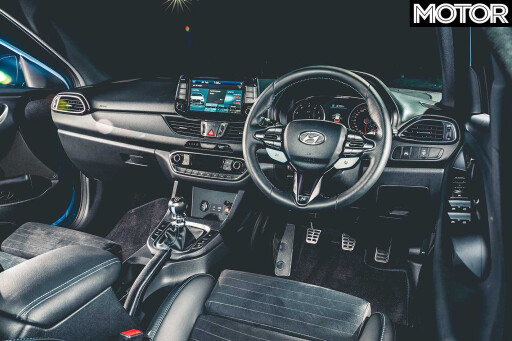 With 271Nm-per-tonne thrusting it forward, the Golf spends little time in the overtaking lane, completing 80-120km/h in 3.77 seconds. The Hyundai’s lesser 250Nm-per-tonne suggests it’s spent too much time at BBQs, however, a better power-to-weight figure keeps the i30 N’s respective sprint to 3.84sec and the gap to just seven-hundredths.
With 271Nm-per-tonne thrusting it forward, the Golf spends little time in the overtaking lane, completing 80-120km/h in 3.77 seconds. The Hyundai’s lesser 250Nm-per-tonne suggests it’s spent too much time at BBQs, however, a better power-to-weight figure keeps the i30 N’s respective sprint to 3.84sec and the gap to just seven-hundredths.
Ditching the smooth stuff for more challenging surfaces reveals the i30 N rides a lot like it did on Rome’s cruddy tarmac at the international launch. Hyundai’s local chassis development team pleaded with Biermann for a country-specific chassis tune during his visit to Australia and they got their way after putting him in a prototype on our worst roads.
The changes are small, and mainly to do with smoothing the damping forces with some re-valving and software tuning to the three-mode adaptive shocks, but they’ve given the i30 N the same flat-riding composure that impressed us in Italy.
The rise and fall of some sections do challenge its suspension travel, and the 19s can drop into holes with a nasty thud – nor is the steering completely isolated from mid-corner bumps – but overall the ride is more than acceptable.
 The Hyundai’s problem, though, is that most of the various things that expose a chink in the way it rides go relatively unnoticed in the Volkswagen. The Golf’s suspension proves firm, but there is enough cushion and control to keep you informed of what’s happening underneath without having to really feel it.
The Hyundai’s problem, though, is that most of the various things that expose a chink in the way it rides go relatively unnoticed in the Volkswagen. The Golf’s suspension proves firm, but there is enough cushion and control to keep you informed of what’s happening underneath without having to really feel it.
Sure, 18-inch tyres with a 40-series profile make the suspension’s job in controlling wheel deflections much easier, but there’s a level of composure and compliance about it that prove the company’s WRC engineers have clearly infiltrated the GTI handling department since they quit competition.
This Golf’s suspension is proof you don’t need adaptive dampers. And without them, there isn’t much reason to delve into the car’s personalised drive mode unless you want to slacken the steering assistance while the engine’s left in Sport.
It’s a completely different story in the i30 N, which you can setup like a GT3 car. You can alter its diff, steering assistance, exhaust noise, dampers, engine response, ESC, and rev-matching crispness through different modes.
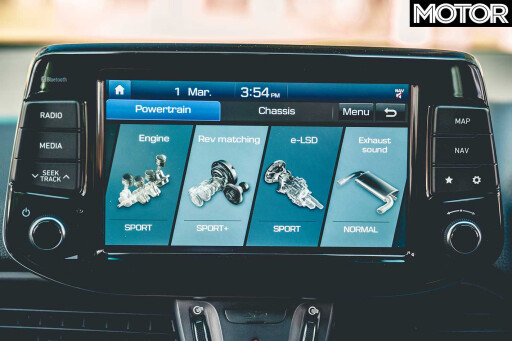 Otherwise, tucked under the right spoke on the steering wheel is an N-mode button. It’s a one-touch solution when you want everything in ‘kill’. Give it another press and the car switches to your personalised ‘custom’ mode.
Otherwise, tucked under the right spoke on the steering wheel is an N-mode button. It’s a one-touch solution when you want everything in ‘kill’. Give it another press and the car switches to your personalised ‘custom’ mode.
As the road surface smooths out and starts to curve, we grit our teeth and engage N mode. We suspect the dampers will turn to concrete and grind our spines to dust. They don’t. And the first thing that strikes you is how much grip the i30 N has.
The fixed-rate steering weights up nicely into the corners with a meaty, linear feel and the front tyres always seem to have enough footing to disperse the engine’s full 378Nm. Without weight on the nose, the i30 can push a little under power. But it will then tighten its line, literally steering itself out of corners.
 It’s also obvious that the front-end’s brilliance hasn’t come at the expense of stability. The grip on offer gives the Hyundai a confidence on unforgiving back-roads that allows you to throw it into corners like a loon.
It’s also obvious that the front-end’s brilliance hasn’t come at the expense of stability. The grip on offer gives the Hyundai a confidence on unforgiving back-roads that allows you to throw it into corners like a loon.
The downside is that while Biermann promised more rear-end liveliness for the production i30 N since a press evaluation of the prototype, it’s lacking the same tail-shake you’d find in a Megane RS or Focus ST. Softening the dampers brings the rear-end into play a little more, but it doesn’t change the car’s focus on using its spread of grip for stability.
This is where the Golf steps in. A GTI Original might be 26kg lighter than its five-door sibling, but the truth is it feels as if twice that has been unloaded from the rear axle. Couple that with the idea a three-door bodyshell is stiffer by design and you have an adjustable chassis. Sure, the Original doesn’t cock its inside rear wheel like a Fiesta ST, but smooth and long damper travel allows a subtle weight shift that transfers grip from the rear to front axle in balletic fashion.
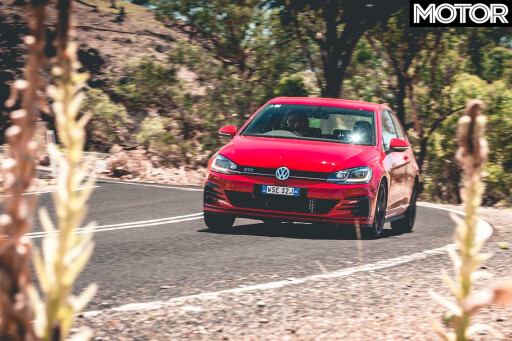 Like all performance Golfs of this generation the Original’s steering points with brilliant precision and the front-end feels wonderfully accurate. By contrast, though, it lacks the i30 N’s textured feedback while the front tyres feel half as wide as there isn’t the same turn-in response from similar steering inputs.
Like all performance Golfs of this generation the Original’s steering points with brilliant precision and the front-end feels wonderfully accurate. By contrast, though, it lacks the i30 N’s textured feedback while the front tyres feel half as wide as there isn’t the same turn-in response from similar steering inputs.
Further dulling its shine is its brake-activated torque vectoring that sometimes bites the inside front tyre with the subtlety of a shark. ESC Sport mode relaxes the system’s enthusiasm, but then frustratingly gives the engine too much leash. Even then, while the i30 N slingshots from bends with consistent tenacity, the Golf might grip to power out from one corner, only to push wide with wheelspin at the next.
There is a solution. If you’re confident enough to use the Golf’s light rear-end to rotate the car before the corner exit, it’ll happily straighten up and give the front tyres more grip, allowing you to drop the hammer on the throttle.
Both cars have precise brake feel on tight, winding roads to help you get a great sense of how hard the pads are biting the discs from the middle pedal. When you start braking later it’s the Golf’s items which pulse first with ABS.
 Inside, though, the Golf is superb. There’s a higher perceived quality about the cabin and its materials. Meanwhile, that integrated 8.0-inch touchscreen looks sleeker and is easier to operate than the Hyundai’s identically sized tablet.
Inside, though, the Golf is superb. There’s a higher perceived quality about the cabin and its materials. Meanwhile, that integrated 8.0-inch touchscreen looks sleeker and is easier to operate than the Hyundai’s identically sized tablet.
It’s a similar situation with the steering wheel controls. There are some important things missing in the Hyundai’s standard equipment list, like all-round parking sensors, that are standard on the Golf.
After a hard day’s driving the Golf’s refined dual-clutch and lighter steering make the GTI a more tantalising prospect for traffic. It won’t be long, though, before you start to miss the i30 N’s charms. Its seating position is lower and inside it’s ergonomically on par with its German rival.
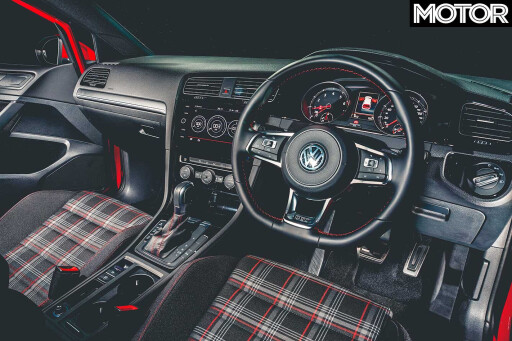 Then there’s that exhaust, which is borderline anti-social in Sport Plus. The pops might sound like bullets exploding in a hot pan, and from the outside it could only be legal in a shooting range, but we love it. That and being able to muck around with the car’s drive mode settings gives the i30 N an extra dimension of involvement and personality on winding roads and in an urban environment.
Then there’s that exhaust, which is borderline anti-social in Sport Plus. The pops might sound like bullets exploding in a hot pan, and from the outside it could only be legal in a shooting range, but we love it. That and being able to muck around with the car’s drive mode settings gives the i30 N an extra dimension of involvement and personality on winding roads and in an urban environment.
On the other hand, the Golf GTI’s clear-minded package is only improved by the Original’s passive suspension and three-door body. Even Sydney Motorsport Park can’t shake its poise and proves its stiffer, lighter chassis thrives on track as well as the road, though the open front differential hurts its corner exit speeds.
The i30 N’s mechanical bits are more at home on the high-speed circuit, as its bigger brakes let you go deeper into corners and its diff lets you squeeze the throttle earlier out of them. But it’s here, more than the road, that the i30 N’s tied down rear-end feels maybe a little too sensible. You walk away from the track dreaming of improvements for both, but while it’s a simple swaybar for the Hyundai, and maybe a small diet, the Golf’s traction problems aren’t so easily solved.
 So, which do you take home? It’s an extremely hard call to make, as they’re both brilliant buys for under $40K. There’s nothing in it for straight-line performance, and when the roads turn bumpy, both cars control the surface rather than it controlling them. Their ESC systems are expertly tuned, however, the pair start to diverge on their dynamic abilities.
So, which do you take home? It’s an extremely hard call to make, as they’re both brilliant buys for under $40K. There’s nothing in it for straight-line performance, and when the roads turn bumpy, both cars control the surface rather than it controlling them. Their ESC systems are expertly tuned, however, the pair start to diverge on their dynamic abilities.
While the Golf’s slightly playful rear-end and stellar ride might be a consolation for its poor traction, its front-end makes the Hyundai’s, even with a smidge of torque steer and tram-lining on wavy roads, seem truly brilliant. And while the Golf can prove rewarding, the Hyundai offers more involvement, feedback, and accessibility.
Day-to-day the Volkswagen excels at being simple, straightforward, and sexy, while the i30 N’s stiffer primary ride and less sophisticated interior knock down its liveability points. The i30 N’s chubbier body pillars also make it harder to see out of its cockpit, but you wouldn’t call it ugly, or expensive.
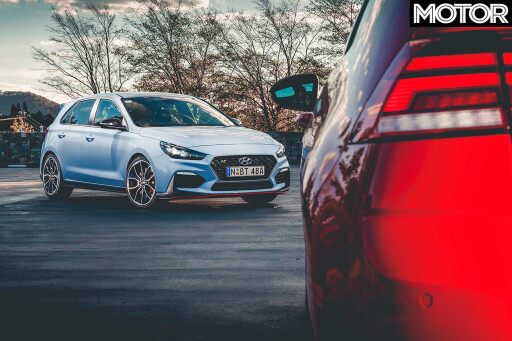 Overall, the Hyundai’s sins are more forgiveable than the Golf’s. Consider its fantastic brakes, hellish exhaust noises, or that its badge doesn’t carry the same cultural cringe, and the i30 N pips the GTI... just.
Overall, the Hyundai’s sins are more forgiveable than the Golf’s. Consider its fantastic brakes, hellish exhaust noises, or that its badge doesn’t carry the same cultural cringe, and the i30 N pips the GTI... just.
And with this battle won, Biermann’s war campaign gains a huge advantage as the diff-equipped GTI Edition 1 three-door must now prove it’s worth an extra $8K. How’s that for blue sky thinking?
Track Battle
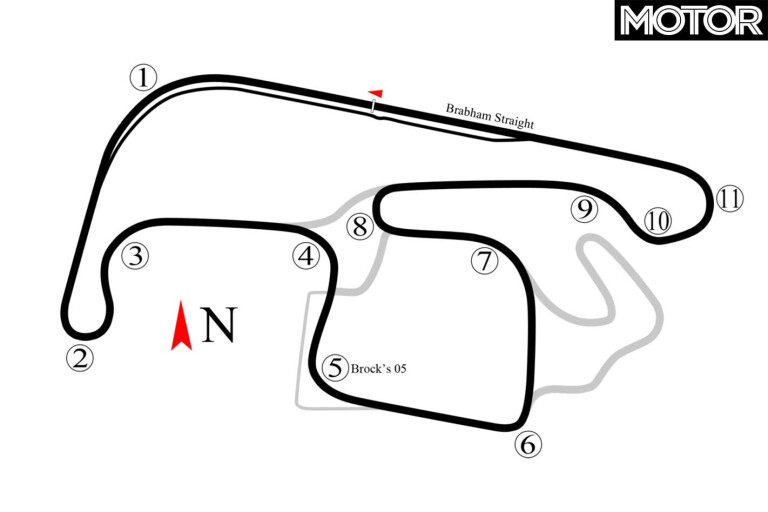
| Golf GTI | i30 N | |
| Turn 2 | 62.4km/h | 59.2km/h |
| Turn 3 | 104.3km/h | 110.7km/h |
| Turn 5 | 101.8km/h | 102.6km/h |
| Turn 8 | 59.5km/h | 63.6km/h |
| Turn 11 | 79.6km/h | 82.9km/h |
| Vmax | 197.9km/h | 196.6km/h |
| Lap Time | 1min 59.6sec | 1min 57.9sec |
Drive: Louis Cordony
While we hoped a public test day at Sydney Motorsport Park would help split this pair, three five-lap sessions in each car only highlighted their respective strengths and weaknesses.
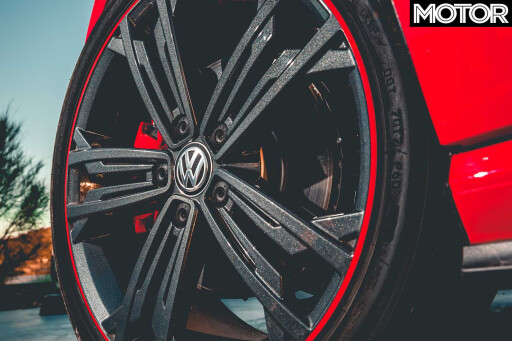 The Golf felt lighter and more precise into corners, while the i30 N had piles more traction at exit. As for brakes, the i30 N’s felt rock solid throughout the day, while the Golf’s were just starting to fade towards the end of their third session. Both ESC systems were imperceptible in Sport settings.
The Golf felt lighter and more precise into corners, while the i30 N had piles more traction at exit. As for brakes, the i30 N’s felt rock solid throughout the day, while the Golf’s were just starting to fade towards the end of their third session. Both ESC systems were imperceptible in Sport settings.
Second Opinion: "It's the Golf GTI for me"
Jackpot. Three corners in a Golf GTI Original and that’s what comes to mind.
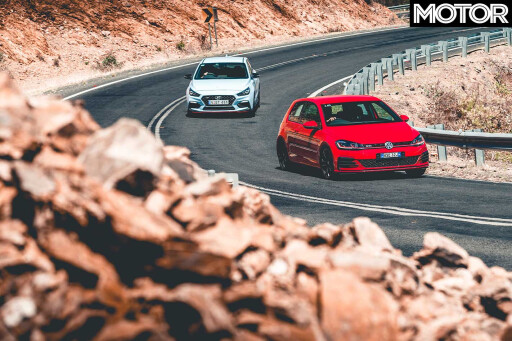 Forget adaptive suspension or overly grippy tyres, because flawless fixed suspension and 18s in a lighter three-door body simply enliven this Mk7.5-gen car. Punchy and playful, the fact this limited edition costs $38,490 driveaway in preferred manual guise makes it the best-value – as well as the best – GTI.
Forget adaptive suspension or overly grippy tyres, because flawless fixed suspension and 18s in a lighter three-door body simply enliven this Mk7.5-gen car. Punchy and playful, the fact this limited edition costs $38,490 driveaway in preferred manual guise makes it the best-value – as well as the best – GTI.
The plucky i30 N is no walk-up winner at $44,063 driveaway. Sure it has 202kW, but it weighs over 1429kg. The N can feel slower, and struggles to hide its extra mass, but the damping is Hyundai’s best yet, the ESC is excellent and the LSD helps deliver slingshot cornering.
What the i30 doesn’t have is the front-end of a Civic Type-R and I feel it should move around more, like the VW. Anyone who calls a Golf boring is wrong, and for this tester, the frisky and fun handler trumps the hard-and-fast by the slimmest of margins. – Dan DeGasperi
Fast Facts

| 2018 Hyundai i30 N | 2018 VW Golf GTI Original | |
| BODY | 5-door, 5-seat hatch | 5-door, 5-seat hatch |
| DRIVE | front-wheel | front-wheel |
| ENGINE | 1998cc inline-4cyl, DOHC, 16v, turbo | 1984cc inline-4cyl, DOHC, 16v, turbo |
| BORE/STROKE | 86 x 86mm | 82.5 x 92.8mm |
| COMPRESSION | 9.5:1 | 9.6:1 |
| POWER | 202kW @ 6000rpm | 169kW @ 4700-6200rpm |
| TORQUE | 353Nm @ 1450-4700rpm (378Nm on overboost) | 350Nm @ 1500-4600rpm |
| WEIGHT | 1509kg | 1326kg |
| POWER/WEIGHT | 134kW/tonne | 127kW/tonne |
| TRANSMISSION | six-speed manual | six-speed dual-clutch |
| SUSPENSION (f) | struts, adaptive dampers, anti-roll bar | struts, dampers, anti-roll bar |
| SUSPENSION (r) | multi-links, adaptive dampers, anti-roll bar | multi-links, dampers, anti-roll bar |
| L/W/H | 4240/1775/1320mm | 4268/1799/1442mm |
| WHEELBASE | 2650mm | 2626mm |
| TRACKS | 1556/1564mm (f/r) | 1538/1516mm (f/r) |
| STEERING | electrically-assisted rack-and-pinion | electrically-assisted rack-and-pinion |
| BRAKES (f) | 345mm ventilated discs, single-piston calipers | 312mm ventilated discs, single-piston calipers |
| BRAKES (r) | 314mm ventilated discs, single-piston calipers | 272mm solid discs, single-piston calipers |
| WHEELS | 19.0 x 8.0-inch (f/r) | 18.0 x 7.5-inch (f/r) |
| TYRE SIZES | 235/35 R19 91Y (f/r) | 225/40 R18 92Y XL (f/r) |
| TYRE | Pirelli P Zero (HN) | Bridgestone Potenza S001 |
| PRICE (as tested) | $42,990* (*Includes Luxury Pack $3000) | $39,990 |
| PROS | Stability; crackling exhaust; sticky front-end; brakes | Slick looks; refined everything; brilliant ride; grunt |
| CONS | Stiff primary ride; 'safe' rear end | Poor traction; steering feedback |
| RATING | 4.5 out of 5 stars | 4 out of 5 stars |

COMMENTS